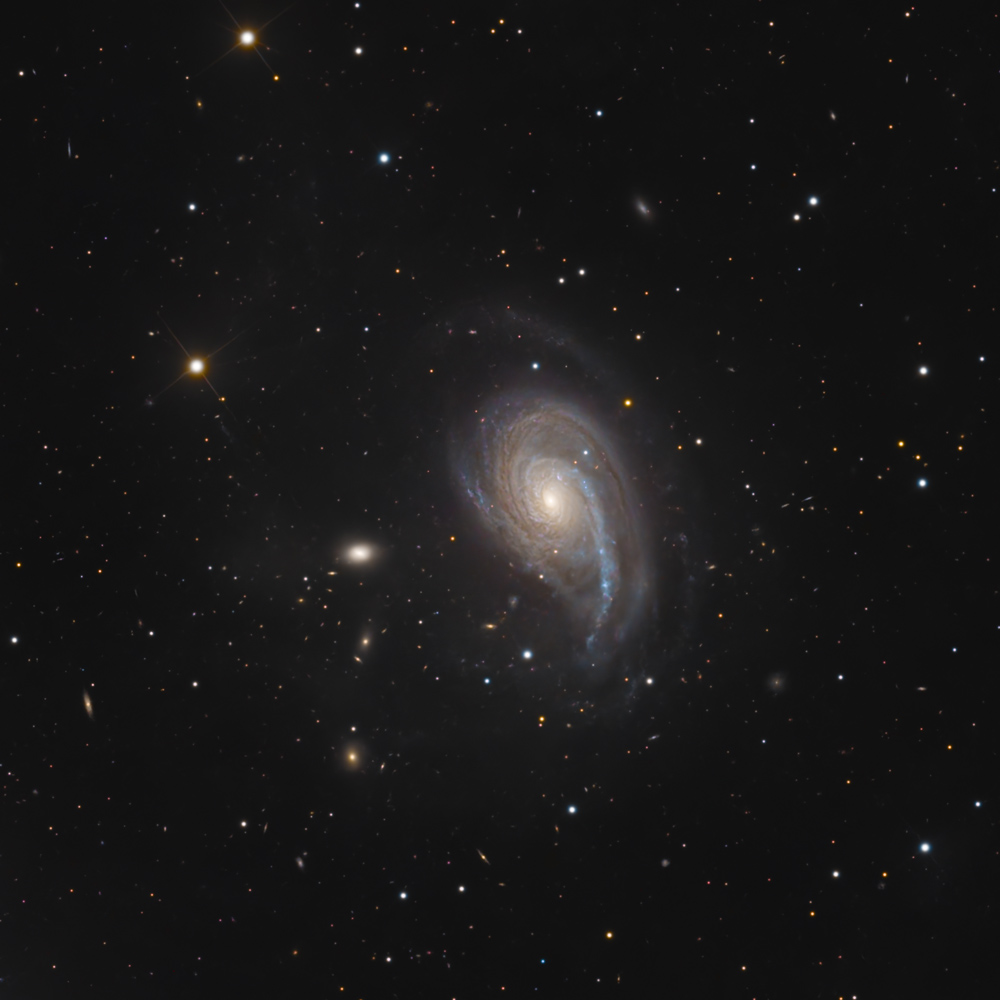

NGC 772 is a spiral galaxy, visually located in the constellation Aries. It presents to us at
a fairly sharp angle from face-on, so it appears very elliptical. It is thought to be about 106 million light years away from us, which would give it a diameter of aboutt 200,000 light
years, making it a very large galaxy (our Milky Way galaxy, itself a large galaxy, now is thought to be a bit over 100,000 light years across). Being so far away, it is only a little more
than 8 arcminutes across in our sky. The entire field of the uncropped versions is about the angular size of a full moon. Technical Information: Ha:L:R:G:B: Images kept: 480:1470:180:330:440 (a total of over 48 hours of light-frame exposure time); but conditions generally were horrible during the extended time
I was trying to gather data, so most of those images I thought were keepers were garbage. I ended up using in the final image 381 minutes of luminance data; 60 minutes of red data;
90 minutes of green data; 140 minutes of blue data, and 460 minutes of Ha data (although the Ha data did not make a signifiant difference in the image). The final image is a composite of:
twelve 30-minute exposures and 7 3-minute exposures through the luminance filter; red and green exposures were all 15-minute exposures; blue were all 20-minute exposures, while Ha were all
20-minute exosures. The luminance layer consisted of an HDR blend of the 30-minute and 3-minute exposures; the red channel is a combination of four 15-minute images thorugh a red filter and
the Ha data. The green channel is a combination of six 15-minute images through the green filter. The blue channel is a combination of seven 20-minute images through a blue filter. Equipment: RC Optical Systems 14.5 inch Ritchey-Chretien carbon fiber truss telescope, with ion-milled optics and RCOS field flattener, at about f/9, and an SBIG STX-16803 camera with
internal filter wheel (SBIG filter set), guided by an SBIG AO-X, all riding on a Bisque Paramount ME German Equatorial Mount. Image Acquisition/Camera Control: Maxim DL, controlled with ACP Expert/Scheduler, working in concert with TheSky X. Processing: All images calibrated (darks, bias and sky flats), aligned, combined and cropped in Pixinsight. Color combine in Pixinsight. Some finish work (gradient removal;
background neutralization, color calibration, NB blend, NoiseXTerminator and BlurXTerminator) done in Pixinsight; some cleanup finish work was done in Photoshop 2024. Location: Data acquired remotely from Sierra Remote Observatories, Auberry, California, USA. Date: Images taken on many nights in December of 2023, and January, October, November and December of 2024 (although I eventually tossed all images taken before October of 2024).
Image posted March 19, 2025. Date: Image scale of full-resolution image: 0.56 arcseconds per pixel. Seeing: Generally quite poor, with an occasional decent night. Calibrated luminance images varied from 1.7 arcsecond FWHM to over 4.1 arcsecond FWHM; I tossed all over 3. CCD Chip temperature: -25C Copyright 2024, 2025
Mark de Regt
It is thought that the its satellite galaxy, the dwarf elliptical galaxy NGC 770 (the elliptical blob to the left of NGC 772) is exerting enough of a gravitational force on NGC 772 to cause
elongated arm of NGC 772, wrapping around the galaxy. A result of that is this galaxy is classified as a "peculiar galaxy." There's a lot of faint glow outside of the brighter parts of the
galaxy; this likely is tidal tails from eons of interactions between NGC 772 and its diminutive satellite (spreading star trails behind NGC 770 as it moves around NGC 772).
This image is a heavily-cropped piece of the entire field I photographed; if you click through where indicated, there are three different resolution versions of the entire (uncropped) version.
As is often the case with large-field deep-sky photographs, there are a lot of tiny (meaning, of course, very far away) galaxies in the background of this photo.